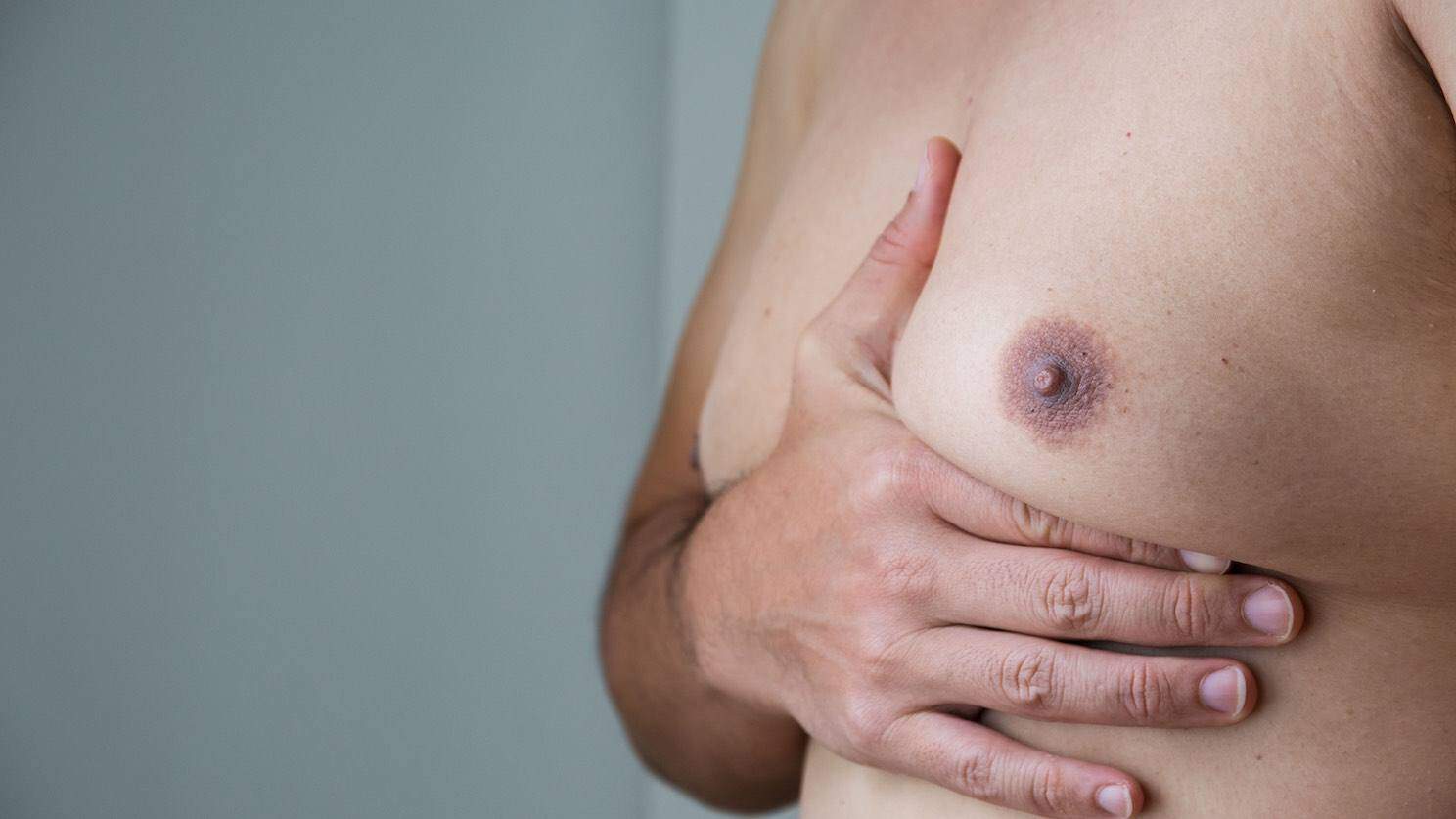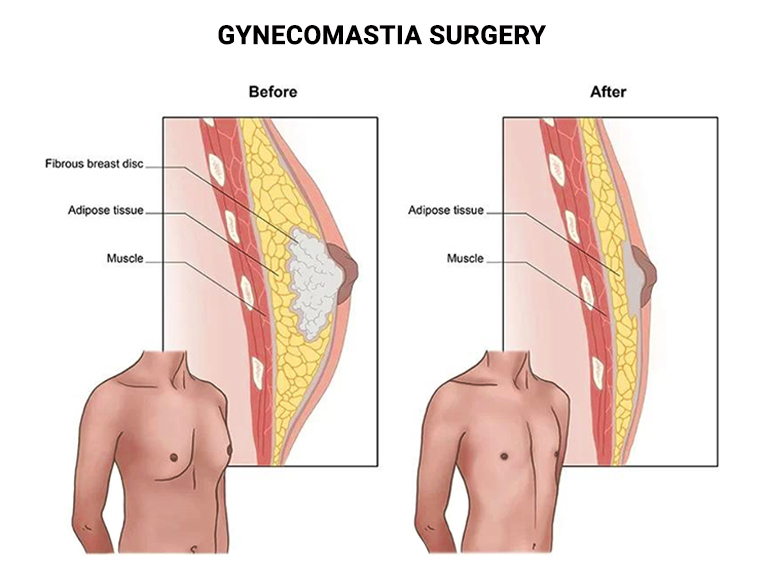Gynecomastia is a condition specific to men. It refers to the enlargement of male breasts due to various reasons such as genetics, excessive weight gain, aging, or hormonal imbalances. Instead of a firm, muscular chest, the appearance of large, fatty, and sagging breasts is considered undesirable and creates an unflattering aesthetic for men.
Men with gynecomastia often feel uncomfortable with their breasts being visible through clothing. This condition can lead to avoiding activities such as swimming or going to the beach and cause feelings of insecurity around the opposite sex, negatively impacting social life. Gynecomastia surgery resolves the issue of enlarged male breasts, helping men achieve a more masculine, toned chest and overcome the social discomfort associated with the condition.
What is Gynecomastia?

Gynecomastia is the enlargement of male breasts. It can occur in infants, during adolescence, and in adulthood. While gynecomastia in infancy and adolescence is considered normal and common (physiological gynecomastia), it is not viewed favorably in adult men. The ideal appearance for adult males is a firm, muscular, and toned chest. If gynecomastia is left untreated, the problem can worsen with age and weight gain. The appearance of feminine-like breasts in men is both socially unaccepted and can cause significant difficulties in a person’s social and private life.
What are the Types of Gynecomastia?
Gynecomastia occurs in three types based on its cause: glandular, lipomatous, and mixed.
- Glandular Gynecomastia: This type involves the enlargement of only the breast tissue, resembling the appearance of female breasts.
- Lipomatous Gynecomastia: In this type, the breast gland remains normal in size, but there is an increase in fat tissue. It is usually seen in overweight men.
- Mixed Gynecomastia: This type occurs due to the excess of both breast tissue and fat. Gynecomastia surgery is most commonly performed on men diagnosed with the mixed type.
Once the type of gynecomastia is determined, the stage is evaluated. Gynecomastia is classified into three stages:
-
- Stage One: The enlargement of the breast is limited, with no sagging of the skin.
- Stage Two: The breast enlargement is significant and resembles the size of a female breast, but there is no sagging of the skin.
- Stage Three: In addition to significant breast enlargement, there is also sagging of the skin.
Based on the type and stage of gynecomastia, a personalized treatment plan is determined by the doctor. For lipomatous gynecomastia in stages one and two, breast reduction can be achieved through liposuction alone. In cases of mixed type in stage three, the only solution is gynecomastia surgery.
What is Gynecomastia Surgery?
For adult men with gynecomastia, surgery can help achieve an ideal chest appearance. Gynecomastia surgery corrects breast deformities, allowing the chest to regain a firm, masculine shape. The procedure is tailored to the individual’s breast condition and needs. In some cases, breast reduction can be achieved with liposuction, while in others, gynecomastia surgery is necessary. In certain situations, a combination of both liposuction and gynecomastia surgery is performed.
Who is Gynecomastia Surgery For?
Gynecomastia surgery is performed on adult men who are dissatisfied with the size of their breasts. To undergo this surgery, patients must be over the age of 18, not be obese, and have no health issues that would prevent surgery.
Gynecomastia surgery is not performed on individuals whose breast enlargement is due to hormonal imbalances. Men with gynecomastia caused by hormonal issues should first undergo hormone therapy to resolve the problem.
How is Gynecomastia Surgery Performed?
Gynecomastia surgery is performed under general anesthesia. In men with excess fat in the breast area and no sagging, Vaser Liposuction is used for treatment. Excess fat in the chest area is removed via liposuction, resulting in a more toned and firm appearance.

If the breast tissue is not enlarged but the skin is loose and sagging, the desired effect can be achieved by combining Liposuction with J Plasma treatments.
In men with the mixed type of gynecomastia, where both breast tissue and fat are in excess, gynecomastia surgery is necessary. During the procedure, which is performed under general anesthesia, an incision is made where the areola meets the skin, and the excess fat and breast tissue are removed. The excess skin is also excised. If needed, Liposuction can be combined with the surgery. Gynecomastia surgery typically lasts 2-3 hours.
What Are the Techniques for Gynecomastia Surgery?
The surgical technique for gynecomastia is determined based on the patient’s breast structure and anatomy. Commonly used gynecomastia surgery techniques include:
Endoscopic Technique: This involves making small 1 cm incisions through which a lighted camera is inserted to remove both breast tissue and fat. The advantages of this technique include minimal scarring and a faster recovery due to the small incisions.
Open Surgery Technique: This technique is suitable for advanced cases of gynecomastia. In addition to removing breast tissue, excess skin is also excised. The open surgery technique reduces breast size and eliminates sagging skin.
What Is Scarless Gynecomastia Surgery?
Scarless gynecomastia surgery is suitable for less advanced cases of gynecomastia. For gynecomastia without skin sagging, liposuction or the endoscopic method is used. Since these methods involve minimal incisions, there are no visible scars after surgery. The recovery process for scarless gynecomastia surgery is also quicker and easier.
What Is the Recovery Process After Gynecomastia Surgery?
Patients can be discharged on the same day after gynecomastia surgery. It is normal to experience bruising, swelling, and edema in the chest area. Some pain, tingling, and numbness may also be felt. These symptoms usually decrease and disappear within a few days. Painkillers, massages, and cold compresses may be recommended by the doctor. Post-operative care includes the following:
- A compression garment should be worn for six weeks.
- Hot showers and steam rooms should be avoided for the first month.
- Strenuous activities and sports should be avoided.
- It is advised to sleep on your back or in a sitting position.
- Harmful habits such as smoking and alcohol consumption should be stopped.
When Will the Desired Results Be Achieved After Gynecomastia Surgery?
Stitches are removed 7 days after gynecomastia surgery, and patients can return to work after one week. The recovery process is typically completed in 3 weeks. If the patient follows the doctor’s instructions and takes proper care of the surgical area, the desired results in the chest area are usually achieved within 3 months.
What Are the Costs of Gynecomastia Surgery?
The cost of gynecomastia surgery varies depending on the type and stage of gynecomastia, the technique used, whether any combined procedures are performed, and the doctor’s experience. The most accurate price information can be obtained after a consultation. By visiting our clinic for an examination, you can learn the type and degree of your gynecomastia, the appropriate treatment method for you, and the surgery cost.
Is Wearing a Compression Garment Necessary After Gynecomastia Surgery?
Wearing a compression garment after gynecomastia surgery is essential to enhance the surgery’s effect. A special compression garment for the chest protects the breasts from impact, helps them achieve the desired shape, and reduces swelling and edema, shortening the recovery period. These garments are adjustable and comfortable to wear.
During the first 3 weeks after surgery, the compression garment should be worn both day and night. For the next 3 weeks, it is only necessary to wear the garment at night. Without wearing the compression garment, the surgery will not be effective, and the chest will not form the desired shape.
Can Gynecomastia Be Resolved Through Exercise?
For younger individuals and early-stage gynecomastia, chest-focused exercises can be beneficial. However, in cases with moderate to advanced fat accumulation, breast tissue enlargement, and skin sagging, exercise will not be effective. In these types of gynecomastia, solutions such as liposuction or gynecomastia surgery are required based on the condition of the breasts.
Will There Be Scars After Gynecomastia Surgery?
If gynecomastia surgery is performed using liposuction or the endoscopic method, no scars are left on the skin. These methods involve minimal incisions, making any scars virtually invisible. In surgeries where the open technique is used, the incision scar will be more prominent. The permanence of the scar varies depending on the individual. Factors such as skin color, hair density, and whether the person smokes can directly influence the visibility of the incision scar.
Are There Non-Surgical Solutions for Gynecomastia?
Non-surgical solutions for gynecomastia, such as exercise, compression vests, or medication, are temporary fixes. Exercise does not effectively reduce breast size in moderate or advanced cases of gynecomastia. Compression vests only offer a temporary visual improvement. To reduce breast size, surgery is needed.
In cases where gynecomastia is caused by hormonal imbalances, hormone therapy can be used. However, this only prevents further enlargement and helps control hormones. Surgery is still required to reduce the breast size and remove sagging skin. The only permanent solution for gynecomastia is surgery.
![dr.leyla-arvas-800×1000.jpg[1] dr.leyla arvas](https://www.quartz.com.tr/wp-content/uploads/2024/11/dr.leyla-arvas-800x1000.jpg1_.webp)
Author : Op. Dr Leyla ARVAS
Dr Leyla Arvas is an internationally recognised specialist in aesthetic surgery based in Istanbul. Graduated in 1998 from Istanbul University Faculty of Medicine, she has developed her expertise by studying in Taiwan, Japan and Spain during her 20 years of experience.
This article April 15, 2025 was updated on
Editor: admin@quartz.com.tr


